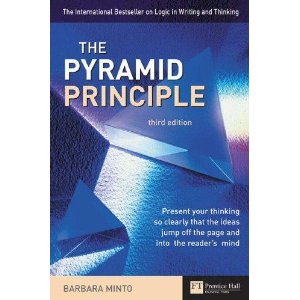The Pyramid Principle (Reseña del libro de Barbara Minto)
El libro consta de dos partes: la primera, dedicada a escribir con lógica, y la segunda, dedicada a pensar con lógica. Aunque las dos son brillantes, la segunda ofrece un mapa conceptual de valor incalculable para aproximarse y dar respuestas a todo tipo de problemas, no sólo profesionales.
Su lectura no es sencilla, como tampoco lo es el resumen presentado a continuación.
Nota. El resumen de Say it With Charts lo tienen también en Know Square:
http://www.knowsquare.es/index.php/component/k2/item/2450-articulo4910
Reseña-crítica
"How odd it is that anyone should not see that all observations must be for or against some view, if they are to be of any service". Charles Darwin
There are several causes for unclear writing. One of them is weakness of style. However, the other main cause, far more pervasive than the first, and much easier to correct, is the structure of the document, the order in which the sentences appear regardless of whether they are well or poorly written. We recommend a pyramid structure to order your ideas, because:
1) The mind automatically sorts information into distinctive pyramidal groupings in order to comprehend it.
o Our brain, faced with a list of units, attempts to impose a logical pattern on them. The pattern will always be that of a pyramid because this is the only form that meets your mind’s need to:
i. Stop at the magical number seven (maximum 9)
ii. State the logic of the relationship
2) Any grouping of ideas is easier to comprehend if it arrives presorted into its pyramid.
3) This suggests that every written document should be deliberately structured to form a pyramid of ideas.
GENERATING THE PYRAMID
There are two ways to get to the pyramid:
a) Ordering from the top down: you give the summarizing idea before you give the individual ideas. A reader comprehends more readily if ideas are presented from the top down.
1) Draw a box (the top of you pyramid)
2) Decide the question. Visualize your reader.
3) Write down the answer if you know it.
4) Identify the Situation, develop the complication
5) Recheck the Question and answer
b) Thinking from the bottom up: beginning with the individual ideas you begin grouping them into logical relationships. If you want to check if you have built the structure properly you need to follow three rules:
1) Ideas at any level in the pyramid must always be summaries of the ideas grouped below them.
2) Ideas in each grouping must always be the same kind of idea. For instance, what if you wanted to group together apples and chairs? You would have to move to a much higher level and call them "things" or "inanimate objects". If the first idea is a step in a process, the rest of ideas must be steps in the same process, and so on. A shortcut is to be sure you can clearly label the ideas with a plural noun.
3) Ideas in each grouping must always be logically ordered. There must be a specific reason why the second idea comes second. There are only four possible logical ways (the only four analytical activities the mind can perform):
i. Deductively (major premise, minor premise, conclusion)
ii. Chronologically (first, second, third)
iii. Structurally (Boston, New York, Washington): when you divide a whole into parts, make sure you apply MECE (ideas Mutually Exclusive from each other, and Collectively Exhaustive of the whole)
iv. Comparatively (first most important, second most important…).
4) To create a bottom-up approach follow a 3-step process:
i. List all the points you think you want to make
ii. Work out the relationships between them.
iii. Draw conclusions
SUBSTRUCTURES WITHIN THE PYRAMID
The rigid set of substructures is:
- The vertical relationship between points and subpoints: it is a question/answer dialogue that will pull the reader with great interest through your reasoning. The reader will be interested because he will be forced to respond logically to your ideas.
- The horizontal relationship within a set of subpoints. It can be:
o Deductive – presents an argument in successive steps or levels. Moving up a level summarizes the argument:
Men are mortal
Socrates is a man
Therefore Socrates is mortal
On the key line level, however, try to avoid using a deductive argument and strive to present your message inductively because it is easier on the reader (i.e., explain the conclusion first and then logically develop it).
o Inductive – This grouping takes a set of ideas that are related simply by virtue of the fact that you can describe them all by the same plural noun:
French tanks are at the Polish border
German tanks are at the Polish border
Russian tanks are at the Polish border
INDUCTION: Poland is about to be invaded by tanks
Inductive reasoning is much more difficult, since it is a more creative activity. You must develop two skills:
a) Define the ideas in the grouping
b) Identify the misfits among them
- The narrative flow of the introduction. The statement that starts off the document must be relevant to the reader: answer a question you have already identify as existing in his mind. Follow the classic pattern of storytelling:
Situation: situation sentences must leave the reader expectant for further information. It establishes the base for a story to come.
Complication: it describes an alteration to the situation.
Question
Answer
Note that the order can be varied.
Thus you make sure that you and the reader are standing in the same place before you take him by the hand and lead him through. It influences his perceptions because it is a biased selection of the relevant details.
I can think only of two situations in which the argument might be more important to the reader than the action: if he is going to disagree strongly with your conclusion, so you must prepare him to accept it, and if he is incapable of understanding the action without prior explanation.
Knowing the vertical relationship, you can determine the kind of ideas you need in each grouping, knowing the horizontal relationship, you can judge that ideas you bring together are of a like kind, and knowing the readers’ question will ensure that the ideas you bring together are relevant.
A few tips:
1) Always try top down first.
2) Use the Situation as the starting point for thinking through the introduction.
3) Limit the introduction to what the reader will agree is true.
4) Be sure to support all key line points (at least one level of support).
5) Key lines should be expressed as ideas, not categories. Do not simply say "Background": explain the background with an idea.
USUAL PATTERNS OF DOCUMENTS
5 types:
o Directives: you ask someone to do something
o Requests for funds
o How to documents: usual in consulting firms.
o Letters of Proposal: the lifeblood of consulting.
o Progress Reviews
TRANSITIONS BETWEEN POINTS AND CONCLUDING
- When making a transition between two points of the structure, try to do it by relating the two elements or sections.
- There is the technique of referencing backward (you pick up a word or phrase in the preceding portion of the pyramid and use it for the next).
- The objective is to make transitions unobtrusive yet clear.
- When concluding, find a compelling set of words that not only sums up for the reader what you have been saying, but also produces an appropriate emotion in him about it (Aristotle). Give him some indication of what he is to think about or is able to do with the new knowledge he now possesses.
- If you create a "Next Steps" section, be sure it has something that the reader will not question (must be logical obvious steps).
LOGICAL THINKING
There are four sets of rules to focus your critical faculties:
a) Question the general order of the ideas
b) Question the problem-solving process:
• Robert Holland in his "Sequential Analysis" proposes a series of questions in logical sequence:
i. What is the problem?
ii. Where does it lie?
iii. Why does it exist?
iv. What could we do about it?
v. What should we do about it?
c) Question your summary statement about them: most readers tie ideas that a general rather than a specific relationship, so that nothing is directly implied. Consequently, they are forced to cap them with intellectually blank assertions such as "the company should have three objectives". So here are two tips:
a. Summarize the action ideas by stating the effect of carrying out the actions
b. Summarize the situation ideas by stating what is implied by their similarity to each other (inference).
d) Question the prose in which you express them
PROBLEM SOLVING IN STRUCTURELESS SITUATIONS
There is another kind of problem situation where the problem is not that you do not like the result but rather that you can’t explain it, usually for three reasons:
a) Because the structure does not yet exist, as when you are trying to invent something new
b) Because the structure is invisible
c) Because the structure fails to explain the result
To face these situations, we do not use deduction or induction, but what Charles Sanders Peirce in 1890 described as "abduction":
- It starts with a result
- To explain it, you create a rule (a belief about the way the world is structured)
- You check the rule to see if it works, therefore obtaining a case (an observed fact)
Deduction, however, starts with a rule you do question and you swiftly move to the case and finally the result. In induction, you start with a case and swiftly obtain a result from where you derive a rule.
Deduction:
Rule: If we put the price too high, sales will go down
Case: We have put the price too high
Result: Therefore, sales will go down
Induction:
Case: We have put the price up
Result: Sales have gone down
Rule: Sales have gone down because price was too high
Abduction:
Result: Sales have gone down
Rule: One reason sales go down is that price is too high
Case: Let me check whether in fact the price is too high
A specific type of abduction is the scientific approach by which we have one of the three essential elements, we invent a second so we can reason our way to the third:
- We hypothesize a structure that could explain the result
- We devise an experiment that will confirm or exclude the hypothesis
- We carry out the experiment
- We recycle the procedure
NOTE – In the book you will find hundreds of examples to the theory exposed above.
Versión digital
En inglés: http://books.google.es/books?id=VseP7-7hCNYC
Sobre el autor
Barbar Minto estudió en la Harvard Business School y se unió a McKinsey and Company en 1963 como su primera consultora femenina. Fue transferida a Londres en 1966 una vez se advirtió su habilidad para escribir, con el objetivo de mejorar las habilidades de escritura del equipo europeo. Los informes estaban escritos en inglés, y se pensaba que los consultores no anglosajones experimentarían algunas dificultades. Minto apreció que las dificultades a la hora de escribir eran las mismas en todos los sitios. No era una cuestión de lenguaje sino de un pensamiento claro. Esto le permitió desarrollar un método de pensamiento y lógica, el resultado del cual es el principio de la pirámide de Minto. Hoy dirige su propia consultora dedicada a formar en este principio.
TRANSPARENCY VOW
El autor de este resumen no conoce al autor ni al editor ni tiene relaciones con la consultora de formación de Minto. La pirámide de Minto ha acompañado al autor de este resumen desde los 21 años.
Título del libro: "The Pyramid Principle"
Editorial: Financial Times – Prentice Hall
Autor: Barbara Minto
1ª edición: 1987
Edición de 2002
173 páginas
Precio: 25 libras

Portada del libro
Adjunto
